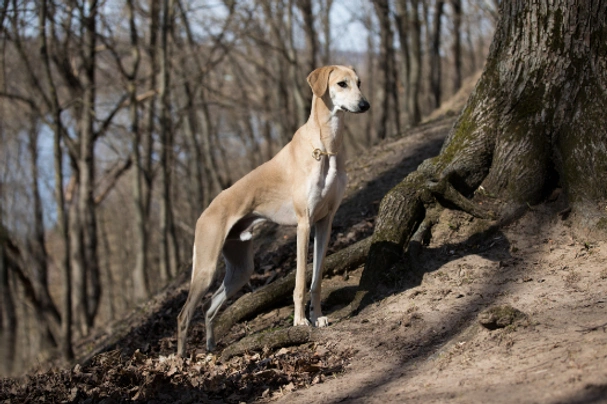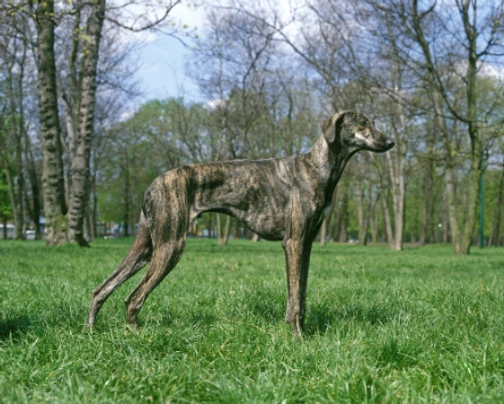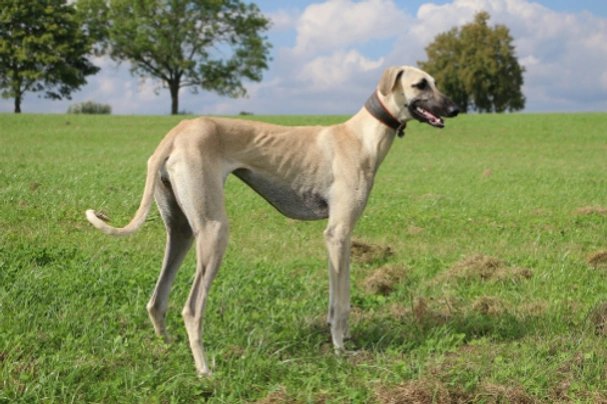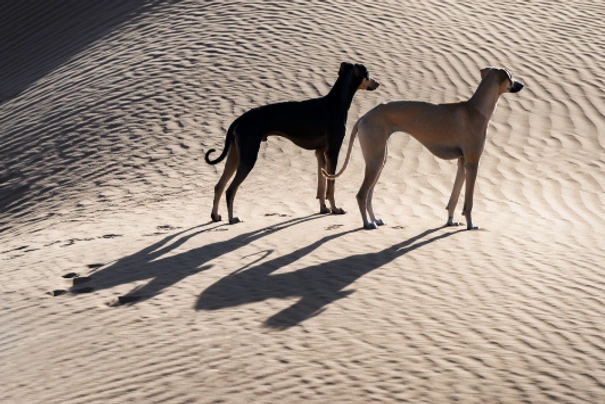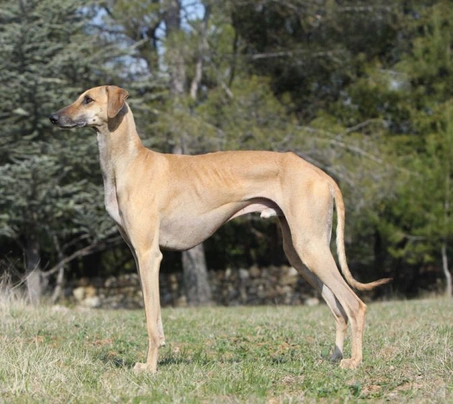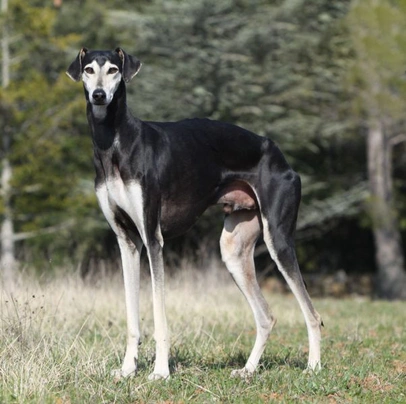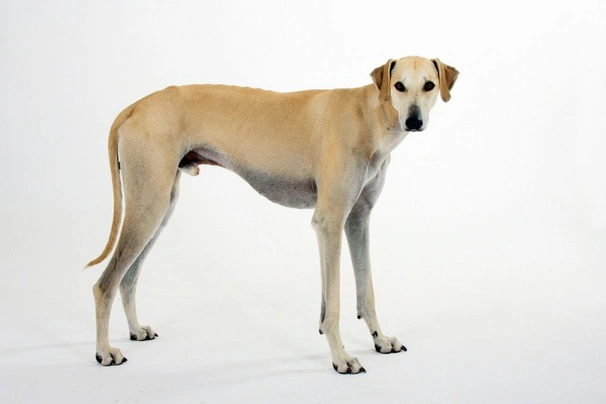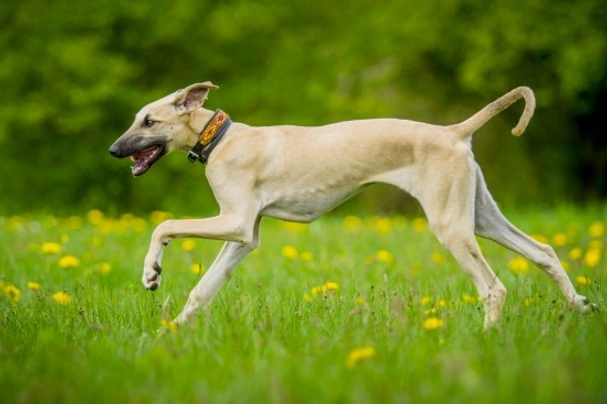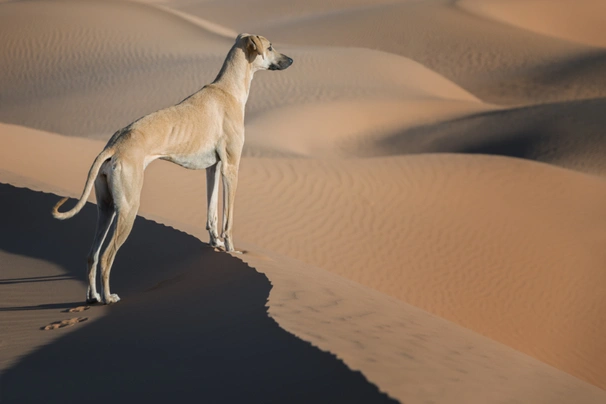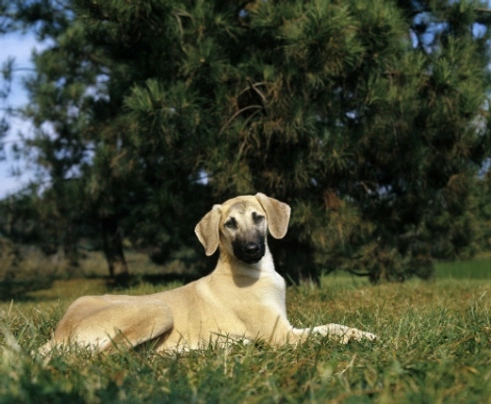Sloughi
Pros
Cons
Introduction of the Sloughi
The Sloughi is an elegant graceful hound that's often called an Arabian Greyhound. They are native to North Africa where they are as highly prized today as they were in ancient times. They are a rare breed with few puppies being registered with the Kennel Club every year which means that finding a well-bred puppy can prove challenging and they often command lots of money.
They were originally bred as sight scent and sound hunting dogs for which they were highly prized in their native North Africa. They are true hounds of the desert but with this said they are just at home in a family environment and as such make wonderful pets although they are not the best choice for first time owners. These elegant hounds do that much better with people who are familiar with the Sloughi breed or similar type of high energy hound and who have the time to dedicate to a highly intelligent hound.
History of the Sloughi
The Sloughi is one of the most ancient sight hounds on the planet with similar dogs having been found in the Sahara regions of North Africa during the Middle Ages. They are thought to have originated in Saudi Arabia but there is much debate as to the true origins of the Sloughi. Throughout the ages these elegant sight hounds have been highly prized not only for their good looks but for their fast turn of speed and hunting skills. In their native lands the Sloughi is as valuable as an Arabian Stallion and they are treated with the same respect as their masters.
The actual origins of this ancient breed remain unknown however with modern technology and the sophisticated DNA tests now available it has been established that Sloughis are more like the Afghan Hound than they are a Saluki and that their ancestors were around thousands of years ago. Artefacts found on digs in Mesopotamia also revealed very similar looking hounds depicted on an ancient coin made around four to five thousand years ago. Similar looking dogs were also found on wall paintings in the ancient tombs of Egyptians pharaohs where they were depicted sitting under their master’s thrones. Even today when a Sloughi dies they're passing is mourned by their Bedouin owners.
There are many records of Sloughis made during the 1800s with descriptions made by Eugène Gayot in 1867 when he was in Algeria of “tall sighthounds” that were used to hunt jackal wild boar gazelle and hartebeest which were highly prized more especially when they were pure-bred. There is a record showing that the King of Algiers sent fawn coloured sighthounds along with Barb horses and lions to the King of France much earlier during the 1500s.
Later in 1852 General Daumas described Algerian Sloughis in a book his wrote called “The Horses of the Sahara”. Many artists and sculptures during both the 18th Century and the 19th Century were inspired to depict Sloughis in their art. A Dutch artist called Auguste Le Gras imported Sloughis to the Netherlands in 1906 and he drew what he perceived to be the “perfect” Sloughi a reference that is still used by breeders and judges today. It would be fair to say that the Sloughi was well-known and admired in many European countries well before their counterparts the Saluki.
It was not until the beginning of the 20th Century that Sloughis first came to the attention of British dog fanciers and it is thought that this was through the efforts of the Hon. Florence Amherst. At the time the breed was referred to as the “Slughi” which means “sighthound” in Arabic. And it’s thought the first sighthounds to be imported to the UK was at the turn of the 20th Century by a man called H. C. Brooke which a Captain J. P. T. Allen had bred.
At first many people thought that the various types of sighthounds found throughout North Africa were one and the same breed. However the Hon. Florence Amherst believed them to be distinctly separate breeds and advised enthusiasts and breeders to be careful when choosing stud dogs with an end goal being to keep “Slughis” as pure as possible and not to cross them with other sighthound breeds. Sadly her advice was ignored and at the end of the Second World War all North African sighthounds were thought to be the same breed which was the Saluki.
By the early seventies the breed once again became popular in Europe with an FCI standard being established in France. In 1972 the first Sloughis were imported to the UK from Sweden and it was these hounds that were to become the foundation stock of R Morland Austin’s Djaeser Kennel. The same year Austin successfully had the breed recognised by the Kennel Club and the first breed classes took place in 1974 at an open show called the Hunting Dogs of Ancient Egypt. In 1999 the Sloughi Club was founded and had 25 members at the time.
Today although the Sloughi is known to be an affectionate and extremely loyal family pet and companion dog they have not enjoyed the same popularity as the Afghan. As such anyone wanting to share a home with one of these elegant sight hounds would need to go on a waiting list because few pedigree puppies are bred and registered with The Kennel Club every year.
Interesting facts about the breed
- Is the Sloughi a vulnerable breed? No although finding well-bred Kennel Club registered puppies in the UK can prove challenging and they often command lots of money
- Native to North Africa Sloughis are national treasures in many countries which includes Libya Tunisia Morocco and Algeria
- The French General Daumas described the Algerian Sloughi in a book he wrote called “The Horses of the Sahara”
- DNA tests have established that Sloughis share more DNA with the Afghan than the Saluki
- A seal discovered in a 3000-year old wall painting in an Egyptian tomb depicts a dog under the pharaoh’s throne which looks very much like a Sloughi
- Even today when a Sloughi dies they are mourned by their owners the Bedouins
- The French claimed that the Sloughi was theirs through the “right of conquest” when they occupied the countries of North Africa
Appearance of the Sloughi
Height at the withers: Males 66 - 72 cm Females 61 - 68 cm
Average weight: Males 22 - 28 kg Females 18 - 23 kg
The Sloughi is an elegant graceful sight hound with males being slighter larger and taller than their female counterparts. They have extremely refined long wedge-shaped heads the tops of which are quite broad and flat with the back of a dog’s head being nicely rounded. They have a slightly pronounced occiput and slight stop with their noses and lips being black in colour although lighter coated dogs can have lighter noses and lips.
Their eyes are large and a nice oval shape being a dark amber in colour and set a little obliquely on a dog's face. Sloughis always have a rather wistful yet gentle expression about their eyes. Their ears are triangular shaped and flat being rounded at the tips. Dogs carry their ears close to their heads and they typically fold downwards. The Sloughi has a strong jaw with a perfect scissor bite where their upper teeth neatly overlap their lower ones.
Their necks are very elegant and nicely proportioned in relation to their body being moderately long and gracefully arched. Their shoulders are long well-muscled and set obliquely on a dog's body. Chests are quite narrow without being excessively so and dogs have slightly sprung ribs which gives them quite a flat appearance. A Sloughi's belly in very tucked up which adds to their elegance and athletic appearance. Their loins are broad muscular and short being gently arched and their toplines are virtually level. They have quite a short croup and their hip bones are very prominent.
A Sloughi’s hindquarters are well-muscled with dogs having long well developed second thighs. Their feet are lean and long very reminiscent of a hare's foot with dog's having well arched toes. Their tails are thin being set well with dogs having a striking curve in their tails when they are excited or alert.
When it comes to their coat the Sloughi has a short fine coat with no feathering anywhere on their bodies or limbs. They can grow an undercoat when the weather is colder. The accepted breed colours for Kennel Club registration are as follows:
- Black Mantle Brindle Points
- Black Mantle Sand Points
- Brindle
- Brindle Black Mask
- Sand
- Sand Black Mask
Sloughis can have a small white mark on their chests which is allowed under their breed standard although it's not that desirable.
It is worth noting that the accepted breed colours for Kennel Club registration can differ from those set out in the breed standard which are as follows:
- Light to red sand with or without black mask
- Brindle with or without black mask
- Black mantle with sand or brindle points
Sloughis can have a small white mark on their chests but it is not very desirable under the breed standard.
Gait/movement
When a Sloughi moves they do so with a smooth free and effortless action never carrying their heads too high and without showing any exaggerated extension.
Faults
The Kennel Club frowns on any exaggerations or departures from the breed standard and would judge the faults on how much they affect a dog's overall health and wellbeing as well as their ability to perform.
Males should have both testicles fully descended into their scrotums and it is worth noting that a dog can be a little lighter or heavier as well as slightly taller or shorter than set out in the Kennel Club breed standard which is only given as a guideline.
Temperament of the Sloughi
The Sloughi is a sensitive and aloof hound by nature but they form extremely strong bonds with their owners and families. They form the strongest bond with one person which is typically the person who takes care and feeds them. They are known to be wary of people they do not know although they would never show any sort of aggression towards a stranger preferring to keep their distance until they get to know someone although they are not known to shy away if someone they don’t know strokes them.
Sloughis are highly intelligent hounds but they need to be handled gently and ideally by someone familiar with the breed or this type of high-energy sensitive hound. Puppies need to be well socialised from a young enough age for them to mature into more confident well-rounded dogs. This must involve introducing them to as many new situations people noises other animals and dogs once they have been fully vaccinated as possible.
Although highly intelligent Sloughis are known to have a bit of a stubborn streak in them. As such they are not the best choice for first time owners because as previously mentioned they need to be handled firmly yet extremely gently to bring the best out of them and to hone their natural abilities.
In a home environment a Sloughi retains an extremely high prey drive and even when extremely well trained some hounds are likely to take off after something they spot in the distance. However because they are so loyal many Sloughis will turn on a sixpence to get back to their owners when they are called but care should always be taken as to where and when one of these high energy hounds can run off the lead just to be on the safe side. They boast having a tremendous amount of stamina which is another thing that owners must bear in mind when exercising a Sloughi.
Are they a good choice for first time owners?
Sloughis are not the best choice for first time dog owners because they need to be socialised handled and trained by people who are familiar with the needs of a high-energy intelligent sighthound.
What about prey drive?
Being sighthounds Sloughis have a high prey drive and will happily chase anything that moves or tries to run away from them when they get the chance. Care must always be taken as to where a Slough can run free more especially if there is wildlife or livestock close by.
What about playfulness?
Sloughis have a playful side to their natures and love to entertain and be entertained. They love to run at speed which is wonderful to watch but they are not very adept at playing games like “fetch” which is true of many sighthounds.
What about adaptability?
Sloughis are better suited to people who live in the country and who lead active outdoor lives. They do not do well living in apartments because they need to be able to express themselves as they should. This means being able to roam around in a secure high fenced back garden whenever possible so dogs can really let off steam. are highly adaptable dogs providing they are given enough daily physical exercise combined with as much mental stimulation to prevent boredom from setting in.
What about separation anxiety?
Sloughis form strong ties with their families and more especially with one person in a household. They are not overly fond of spending too much time on their own although they are not known to suffer from separation anxiety. With this said no breed likes to be left to their own devices for extended periods of time which could result in them developing some destructive and unwanted behaviours around the home.
What about excessive barking?
Sloughis are not known to be “barkers” and will typically only voice an opinion when they think it is necessary to do so or when they want something.
Do Sloughis like water?
Most Sloughis like splashing around in water however anyone who owns a dog that does not like water should never force them to go in because it would just end up scaring them. With this said care should always be taken when walking a Sloughi off the lead anywhere near more dangerous watercourses just in case a dog decides to leap in or falls in and then needs rescuing because they cannot get out of the water on their own.
Are Sloughis good watchdogs?
Sloughis are very good watchdogs and will guard and protect their owners and their property with no second thoughts at all because they are so incredibly loyal. However rarely would a Sloughi show any sort of aggressive behaviour preferring to stand their ground when strangers are around.
Intelligence / Trainability of the Sloughi
The Sloughi is a highly intelligent dog but they can be stubborn which is why they are best handled and trained by people who understand the needs of such a high energy sight hound. In the right hands and with the right amount of socialisation Sloughis are ready and willing to learn providing their training remains consistent and always fair so that dogs understand what is expected of them.
Their training must start as early as possible and because these hounds are so sensitive to voice care must be taken as to how their handled and trained. They do not respond well to any sort of harsh correction which could end up making a dog a lot more reserved and timid. However they do respond well to positive reinforcement training. It’s important to bear in mind that because they boast such high prey drives even some of the best trained Sloughis might choose to ignore a "recall" command if they spot something more interesting in the distance whereas others will turn rapidly to get back to their owners as fast as they can.
Like all puppies Sloughis when young are incredibly cute and it is all too easy to spoil them when they first arrive in their new homes. However once a puppy is nicely settled owners must start out as they mean to go on which means laying down ground rules and boundaries so that a puppy knows what an owner expects of them. It also helps establish a pecking order and who the alpha dog is in a household. The first commands a puppy should be taught are as follows:
- Come
- Sit
- Stay
- Heel
- Quiet
- Leave it
- Down
- Bed
Children and other
Sloughis have a real affinity with children and thrive on being around them. However care should always be taken when the kids play with a dog. As such any interaction between them should always be supervised by an adult just in case play time gets too boisterous. With this said they are best suited to families where the children in a household are slightly older and who therefore know how to behave around dogs bearing in mind that Sloughis like living in a quieter environment and get nervous when things get too noisy.
They are generally good around other dogs especially if they have been well socialised from a young enough age. Care must be taken when they are around any smaller pets and animals which includes cats because a Sloughi could see them as prey with disastrous results.
Health of the Sloughi
The average life expectancy of a Sloughi is between 12 and 15 years when properly cared for and fed an appropriate good quality diet to suit their ages.
The Sloughi is known to be a healthy dog but there are a few of health issues that seem to affect the breed which are as follows:
- Progressive Retinal Atrophy (PRA) – dog should be eye tested through the Animal Health Trust
- A sensitivity to anaesthetics and sedatives
- An immune system deficiency
What about vaccinations?
Sloughi puppies would have been given their initial vaccinations before being sold but it is up to their new owners to make sure they have their follow-up shots in a timely manner with the vaccination schedule for puppies being as follows:
- 10 -12 weeks old bearing in mind that a puppy would not have full protection straight away but would be fully protected 2 weeks after they have had their second vaccination
There has been a lot of discussion about the need for dogs to have boosters. As such it's best to talk to a vet before making a final decision on whether a dog should continue to have annual vaccinations which are known as boosters.
What about spaying and neutering?
A lot of vets these days recommend waiting until dogs are slightly older before spaying and neutering them which means they are more mature before undergoing the procedures. As such they advise neutering males and spaying females when they are between the ages of 6 to 9 months old and sometimes even when a dog is 12 months old.
Other vets recommend spaying and neutering dogs when they are 6 months old but never any earlier unless for medical reasons. With this said many breeds are different and it is always advisable to discuss things with a vet and then follow their advice on when a dog should be spayed or neutered.
What about obesity problems?
Sloughis are not known to have weight problems thanks to their build. However like other breeds some hounds gain weight after they have been spayed or neutered and it's important to keep an eye on a dog's waistline just in case they do. If a dog starts to put on weight it's important to adjust their daily calorie intake and to up the amount of exercise they are given. Older dogs too are more prone to gaining weight and again it's essential they be fed and exercised accordingly because obesity can shorten a dog's life by several years. The reason being that it puts a lot of extra strain on a dog's internal organs including the heart which could prove fatal.
What about allergies?
Sloughis are not known to suffer from allergies but it's important for a dog to see a vet sooner rather than later if one flares up. Allergies can be notoriously hard to clear up and finding the triggers can be challenging. With this said a vet would be able to make a dog with an allergy more comfortable while they try to find out the triggers which could include the following:
- Certain dog foods that contain high levels of grains and other cereal-type fillers
- Airborne pollens
- Dust mites
- Environment
- Flea and tick bites
- Chemicals found in everyday household cleaning products
Participating in health schemes
All responsible Sloughi breeders would ensure that their stud dogs are tested for known hereditary and congenital health issues known to affect the breed by using the following schemes:
- Progressive retinal atrophy (PRA) through the Animal Health Trust (AHT)
What about breed specific breeding restrictions?
Apart from the standard breeding restrictions that are in place for all Kennel Club registered breeds there are no other breed specific breeding restrictions in place for the Sloughi.
What about Assured Breeder Requirements?
Currently there are no Kennel Club Assured Breeder requirements in place for the Sloughi.
Caring for the Sloughi
As with any other breed Sloughis need to be groomed on a regular basis to make sure their coats and skin are kept in top condition. They also need to be given regular daily exercise to ensure they remain fit and healthy. On top of this dogs need to be fed good quality food that meets all their nutritional needs throughout their lives.
Caring for a Sloughi puppy
Sloughi puppies can be boisterous and full of life which means it's essential for homes and gardens to be puppy-proofed well in advance of their arrival. A responsible breeder would have well socialised their puppies which always leads to more outgoing confident and friendly dogs right from the word go. With this said any puppy is going to feel vulnerable when they leave their mother and littermates which must be taken into account. The longer a puppy can remain with their mother the better although it should never be for too long either.
It's best to pick a puppy up when people are going to be around for the first week or so which is the time needed for a puppy to settle in. Puppy-proofing the home and garden means putting away any tools and other implements that a boisterous puppy might injure themselves on. Electric wires and cables must be put out of their reach because puppies love chewing on things. Toxic plants should be removed from flowerbeds and the home too.
Puppies need to sleep a lot to grow and develop as they should which means setting up a quiet area that's not too out of the way means they can retreat to it when they want to nap and it's important not to disturb them when they are sleeping. It's also a good idea to keep "playtime" nice and calm inside the house and to have a more active "playtime" outside in the garden which means puppies quickly learn to be less boisterous when they are inside.
The documentation a breeder provides for a puppy must have all the details of their worming date and the product used as well as the information relating to their microchip. It is essential for puppies to be wormed again keeping to a schedule which is as follows:
- Puppies should be wormed at 6 months old
- They need to be wormed again when they are 8 months old
- Puppies should be wormed when they are 10 months old
- They need to be wormed when they are 12 months old
Things you'll need for your puppy
There are certain items that new owners need to already have in the home prior to bringing a new puppy home. It's often a good idea to restrict how much space a puppy plays in more especially when you can't keep an eye on what they get up to bearing in mind that puppies are often quite boisterous which means investing in puppy gates or a large enough playpen that allows a puppy the room to express themselves while keeping them safe too. The items needed are therefore as follows:
- Good quality puppy or baby gates to fit on doors
- A good well-made playpen that's large enough for a puppy to play in so they can really express themselves as puppies like to do
- Lots of well-made toys which must include good quality chews suitable for puppies to gnaw on bearing in mind that a puppy will start teething anything from when they are 3 to 8 months old
- Good quality feed and water bowls which ideally should be ceramic rather than plastic or metal
- A grooming glove
- A slicker brush or soft bristle brush
- Dog specific toothpaste and a toothbrush
- Scissors with rounded ends
- Nail clippers
- Puppy shampoo and conditioner which must be specifically formulated for use on dogs
- A well-made dog collar or harness
- A couple of strong dog leads
- A well-made dog bed that's not too small or too big
- A well-made dog crate for use in the car and in the home that's large enough for a puppy to move around in
- Baby blankets to put in your puppy's crate and in their beds for when they want to nap or go to sleep at night
Keeping the noise down
All puppies are sensitive to noise including Sloughi puppies. It's important to keep the noise levels down when a new puppy arrives in the home. TVs and music should not be played too loud which could end up stressing a small puppy out resulting in them being withdrawn timid and shy.
Keeping vet appointments
As previously mentioned Sloughi puppies would have been given their first vaccinations by the breeders but they must have their follow up shots which is up to their new owners to organise. The vaccination schedule for puppies is as follows:
- 10 -12 weeks old bearing in mind that a puppy would not have full protection straight away but would only be fully protected 2 weeks after they have had their second vaccination
When it comes to boosters it's best to discuss these with a vet because there is a lot of debate about whether a dog really needs them after a certain time. However if a dog ever needed to go into kennels their vaccinations would need to be fully up to date.
What about older Sloughis when they reach their senior years?
Older Sloughis need lots of special care because as they reach their golden years they are more at risk of developing certain health concerns. Physically a dog's muzzle may start to go grey but there will be other noticeable changes too which includes the following:
- Coats become coarser
- A loss of muscle tone
- They can either become overweight or underweight
- They have reduced strength and stamina
- Older dogs have difficulty regulating their body temperature
- They often develop arthritis
- Immune systems do not work as efficiently as they once did which means dogs are more susceptible to infections
- Older dogs change mentally too which means their response time tends to be slower as such they develop the following:
- They respond less to external stimuli due to impaired vision or hearing
- They tend to be a little pickier about their food
- They have a lower pain threshold
- Become intolerant of any change
- Often an older dog can feel disorientated
Living with a Sloughi in their golden years means taking on a few more responsibilities but these are easily managed and should include looking at their diet the amount of exercise they are given how often their dog beds need changing and keeping an eye on the condition of their teeth.
Older Sloughis need to be fed a good quality diet that meets their needs at this stage of their lives all the while keeping a close eye on a dog's weight. A rough feeding guide for older dogs is as follows bearing in mind they should be fed highly digestible food that does not contain any additives:
- Protein content should be anything from 14 – 21%
- Fat content should be less than 10%
- Fibre content should be less than 4%
- Calcium content should be 0.5 – 0.8%
- Phosphorous content should be 0.4 – 0.7%
- Sodium content should be 0.2 – 0.4%
Older Sloughis don't need the same amount of daily exercise as a younger dog but they still need the right amount of physical activity to maintain muscle tone and to prevent a dog from putting on too much weight. All dogs need access to fresh clean water and this is especially true of older dogs when they reach their golden years because they are more at risk of developing kidney disorders.
Grooming of the Sloughi
The Sloughi has a short tight coat and they only grow an undercoat if the weather turns cold. As such they are low maintenance on the grooming front. A weekly brush and a wipe over with a chamois leather will help keep their coats shiny and looking good. With this said Sloughis only shed a little although more so during the Spring and then again in the Autumn when they tend to shed a little more than at other times of the year. One lovely trait about the Sloughi is that they like to keep themselves extremely clean and are very cat-like in their grooming habits.
It's also important to check a dog's ears on a regular basis and to clean them when necessary. If too much wax builds up in a dog's ears it can lead to a painful infection which can be hard to clear up. In short prevention is often easier than cure when it comes to ear infections.
Exercise of the Sloughi
The Sloughi is an intelligent high energy hound and as such they need to be given the right amount of daily stimulation and exercise to be truly happy well-rounded dogs that are a pleasure to have around. Ideally a Sloughi needs at least 2 hour's exercise every day and as much off the lead time as possible but always in a safe and secure area because if a Sloughi picks up an interesting scent they will be more than tempted to go off in search of what's at the end of it.
A shorter walk in the morning would be fine but a longer more interesting one in the afternoon is a must. These dogs also like to be able to roam around a back garden as often as possible so they can really let off steam. However the fencing must be extremely secure to keep these high energy dogs in because if they find a weakness in the fence they will soon escape out and get into all sorts of trouble.
With this said Sloughi puppies should not be over exercised because their joints and bones are still growing. This includes not letting a dog jump up and down from furniture or going up or down the stairs. Too much pressure placed on their joints and spines at an early age could result in a dog developing serious problems later in their lives.
Feeding of the Sloughi
If you get a Sloughi puppy from a breeder they would give you a feeding schedule and it's important to stick to the same routine feeding the same puppy food to avoid any tummy upsets. You can change a puppy's diet but this needs to be done very gradually always making sure they don't develop any digestive upsets and if they do it's best to put them back on their original diet and to discuss things with the vet before attempting to change it again. One thing worth noting is that Sloughis prefer to eat their food off the ground much like other desert bred hounds.
Older dogs are not known to be fussy or finicky eaters but this does not mean you can feed them a lower quality diet. It's best to feed a mature dog twice a day once in the morning and then again in the evening making sure it's good quality food that meets all their nutritional requirements. It's also important that dogs be given the right amount of exercise so they burn off any excess calories or they might gain too much weight which can lead to all sorts of health issues. Obesity can shorten a dog's life by several years so it's important to keep an eye on their waistline from the word go**.**
Feeding guide for a Sloughi puppy
Puppies need to be fed a highly nutritious good quality diet for them to develop and grow as they should. As a rough guide a Sloughi puppy can be fed the following amounts every day making sure their meals are evenly spread out throughout the day and it's best to feed them 3 or 4 times a day:
- 2 months old - 274g to 297g depending on puppy's build
- 3 months old - 344g to 393g depending on puppy's build
- 4 months old - 374g to 435g depending on puppy's build
- 5 months old - 413g to 517g depending on puppy's build
- 6 months old - 450g to 589g depending on puppy's build
- 7 months old - 450g to 590g depending on puppy's build
- 8 months old - 419g to 586g depending on puppy's build
- 9 months old - 391g to 546g depending on puppy's build
- 10 months old - 356g to 510g depending on puppy's build
- 11 months old - 323g to 465g depending on puppy's build
- 12 months old - 321g to 423g depending on puppy's build
- 13 months old - 320g to 420g depending on puppy's build
- 14 months old - 318g to 410g depending on puppy's build
Once a puppy is 15 months old they can be fed adult dog food.
Feeding guide for an adult Sloughi
Once fully mature an adult Sloughi should be fed a good quality diet to ensure their continued good health. As a rough guide an adult dog can be fed the following amounts every day:
- Dogs weighing 18 kg can be fed 280g to 363g depending on activity
- Dogs weighing 22 kg can be fed 292g to 382g depending on activity
- Dogs weighing 23 kg can be fed 307g to 409g depending on activity
- Dogs weighing 28 kg can be fed 312g to 414g depending on activity
Sloughi price
If you are looking to buy a Sloughi you would need to register your interest with breeders and agree to being put on a waiting list because so few puppies are bred and registered with The Kennel Club every year. You would need to pay anything upwards of £600 for a well-bred pedigree puppy. The cost of insuring a male 3-year-old Sloughi in northern England would be £29.31 a month for basic cover but for a lifetime policy this would set you back £54.65 a month (quote as of October 2018). When insurance companies calculate a pet's premium they factor in several things which includes where you live in the UK a dog's age and whether they have been neutered or spayed among other things.
When it comes to food costs you need to buy the best quality food whether wet or dry making sure it suits the different stages of a dog’s life. This would set you back between £40 - £50 a month. On top of this you need to factor in veterinary costs if you want to share your home with a Sloughi and this includes their initial vaccinations their annual boosters the cost of neutering or spaying a dog when the time is right and their yearly health checks all of which quickly adds up to over £1000 a year.
As a rough guide the average cost to keep and care for a Sloughi would be between £60 to £110 a month depending on the level of insurance cover you opt to buy for your dog but this does not include the initial cost of buying a well-bred Kennel Club registered pedigree Sloughi puppy.
Buying advice
When visiting and buying any puppy or dog there are many important things to consider and questions to ask of the breeder/seller. You can read our generic puppy/dog advice here which includes making sure you see the puppy with its mother and to verify that the dog has been wormed and microchipped.
Sloughis are rare in the UK which means that well-bred puppies can command a lot of money. As such with Sloughis there is specific advice questions and protocols to follow when buying a puppy which are as follows:
- Prospective owners may come across online and other adverts showing images of adorable Sloughi puppies for sale. However the sellers ask buyers for money up front before agreeing to deliver a puppy to a new home. Potential buyers should never buy a puppy unseen and should never pay a deposit to a seller before collecting a puppy from them
- As previously touched upon finding Sloughi puppies in the UK can prove very challenging and waiting lists tend to be long with puppies costing a lot of money. As such some amateur breeders/people breed from a dam far too often so they can make a quick profit without caring for the welfare of the puppies their dam or the breed in general. Under Kennel Club rules a dam can only produce 4 litters and she must be between a certain age to do so. Anyone wishing to buy a Sloughi puppy should think very carefully about who they purchase their puppy from and should always ask to see the relevant paperwork pertaining to a puppy's lineage their vaccinations and their microchipping
- Prospective owners must always ensure that Sloughi puppies are Kennel Club registered and that both parents are pure breeds
